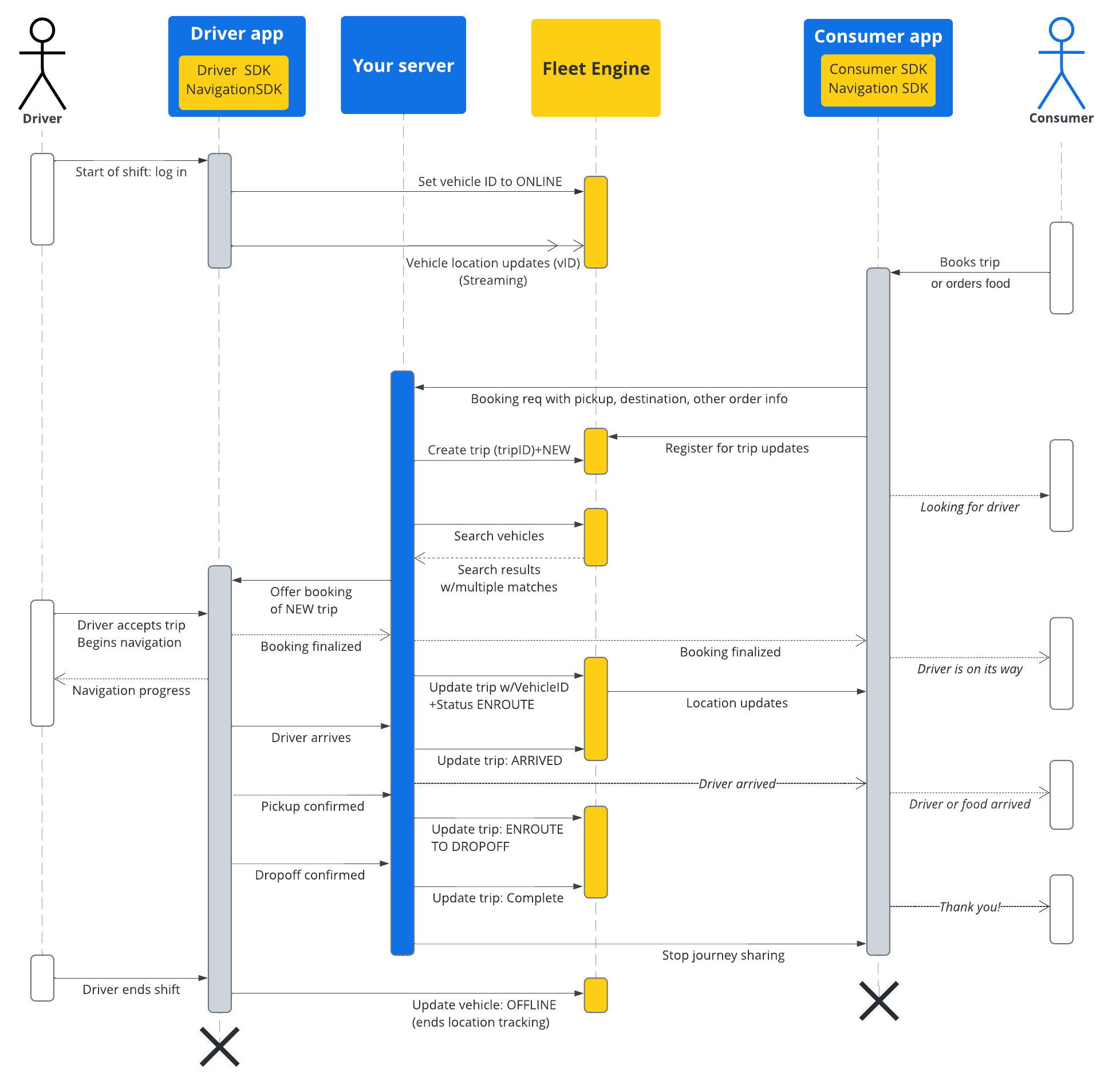এই বিভাগের ডকুমেন্টেশনে দেখানো হয়েছে যে গুগল ম্যাপস মোবিলিটি অন-ডিমান্ড ট্রিপ পরিষেবা ব্যবহার করে কীভাবে ট্রিপ তৈরি এবং কাজ করতে হয়। এটি নিম্নলিখিত বিষয়গুলির সাথে পরিচিতি ধরে নেয়:
- ফ্লিট ইঞ্জিন : আপনার ফ্লিট ইঞ্জিন বাস্তবায়নের বিবরণ, অনুরোধ প্রক্রিয়া এবং নিরাপত্তা সম্পর্কে পরিচিত হওয়া উচিত। এর জন্য, ফ্লিট ইঞ্জিন পরিষেবা কী? এবং সেট আপ ফ্লিট ইঞ্জিন বিভাগে নিরাপত্তা বিষয়গুলি দেখুন।
- চাহিদা অনুযায়ী পরিষেবার জন্য যানবাহনের মৌলিক বিষয় । যানবাহনের ভূমিকা দেখুন।
- অন-ডিমান্ড পরিষেবার জন্য ট্রিপের মূল বিষয়গুলি । অন-ডিমান্ড ট্রিপ দেখুন।
আপনি যে TripService ব্যবহার করবেন তা gRPC এবং REST এর জন্য উপলব্ধ। সহজতার জন্য, ফিল্ড রেফারেন্সগুলি gRPC কনভেনশন অনুসরণ করে।
অন-ডিমান্ড পরিষেবার জন্য Fleet Engine-এ, ট্রিপ হল এক ধরণের যাত্রা যা আপনার গ্রাহকদের কাছ থেকে খাবার ডেলিভারি বা রাইডের অনুরোধ পূরণের মডেল তৈরি করে। একটি ট্রিপের একটি স্ট্যাটাস থাকে যা আপনি যাত্রার পরিবর্তনের সাথে সাথে Fleet Engine-কে রিপোর্ট করেন, যেমন NEW , ENROUTE_TO_PICKUP , এবং আরও অনেক কিছু। ট্রিপের স্ট্যাটাস গাড়ির জন্য নির্ধারিত ভূ-অবস্থানযুক্ত ওয়েপয়েন্টের সাথে মিলে যায় এবং Fleet Engine আপনার করা প্রতিটি ট্রিপ আপডেটের সাথে এই গাড়ির ওয়েপয়েন্টগুলি পরিবর্তন করে। ট্রিপ এবং যানবাহনের সাথে তাদের সম্পর্ক সম্পর্কে আরও জানতে Fleet Engine-এর প্রয়োজনীয়তাগুলিতে অন-ডিমান্ড ট্রিপগুলি দেখুন।
ভ্রমণের জীবন
ফ্লিট ইঞ্জিনে প্রতিটি ট্রিপ ট্র্যাক করার জন্য, আপনাকে প্রথমে একটি Trip এন্টিটি তৈরি করতে হবে। রেফারেন্সের জন্য gRPC অথবা REST দেখুন।
নিচের টেবিলটি আপনার সিস্টেমে তৈরি একটি ট্রিপের এন্ড-টু-এন্ড প্রবাহ এবং ফ্লিট ইঞ্জিনে এর জীবনচক্রের ধাপগুলির একটি উদাহরণ বর্ণনা করে। এটি ধরে নেয় যে আপনি ফ্লিট ইঞ্জিন সেট আপ করেছেন এবং ট্রিপের জন্য নির্ধারিত একটি গাড়ি আছে, ড্রাইভার অ্যাপে অবস্থান আপডেট সক্ষম করা আছে। ড্রাইভার SDK দেখুন: অন-ডিমান্ড ট্রিপস ।
| ১ | বুকিং অনুরোধ গ্রহণ করুন। | ফ্লিট ইঞ্জিন ট্রিপ শুরু হওয়ার আগে, আপনার বুকিং সিস্টেম প্রথমে আপনার অ্যাপ বা অন্যান্য বুকিং সিস্টেমের মাধ্যমে একজন গ্রাহকের কাছ থেকে রাইড বা ডেলিভারির জন্য একটি অনুরোধ পায়। এরপর আপনার সিস্টেম CreateTrip ব্যবহার করে প্রয়োজনীয় ক্ষেত্রগুলি, যেমন পিকআপ লোকেশন, ব্যবহার করে ট্রিপ সত্তা তৈরি করে। এটি এই সময়ে অন্যান্য ক্ষেত্রগুলিও সেট করতে পারে, যেমন যাত্রী এবং ড্রপঅফ লোকেশন, অথবা এটি একটি যানবাহন নির্ধারণ না করা পর্যন্ত অপেক্ষা করতে পারে। একটি একক-গন্তব্য ট্রিপ তৈরি করুন দেখুন। |
| ২ | গাড়ি বরাদ্দ করুন। | আপনি আপনার সিস্টেমের মধ্যে সরাসরি ট্রিপের জন্য যানবাহন বরাদ্দ করতে পারেন এবং ফ্লিট ইঞ্জিনকে অ্যাসাইনমেন্টটি রিপোর্ট করতে পারেন, অথবা আপনি যানবাহন অনুসন্ধানের জন্য অনুসন্ধান যানবাহন পরিষেবা ব্যবহার করতে পারেন, ট্রিপ এবং যানবাহন উভয় বৈশিষ্ট্য দ্বারা ফিল্টার করে যাত্রা সম্পন্ন করার জন্য সেরা যানবাহনটি খুঁজে পেতে পারেন। আপনার অনুসন্ধান ব্যাসার্ধের মধ্যে থাকা যেকোনো অনলাইন যানবাহন ড্রাইভার SDK দ্বারা প্রদত্ত অবস্থান আপডেটের মাধ্যমে তাদের নৈকট্য সম্পর্কে অবহিত করে। একবার |
| ৩ | ট্রিপ আপডেট করুন। | ড্রাইভার একবার ট্রিপ গ্রহণ করে এবং পিকআপ লোকেশনে নেভিগেট করা শুরু করলে, আপনার সিস্টেম ট্রিপের স্ট্যাটাস NEW থেকে ENROUTE_TO_PICKUP এ আপডেট করে। আপনি পুরো যাত্রা জুড়ে গাড়ির অবস্থান পোল করতে থাকেন, হয় অ্যাপ থেকে আপনার ব্যাকএন্ডে সরাসরি সংযোগের মাধ্যমে, অথবা Fleet Engine পোল করে, যা Driver SDK থেকে গাড়ির অবস্থান আপডেটের একটি চলমান স্ট্রিম পায়। তারপর আপনার সিস্টেম প্রতিটি যাত্রা মাইলফলক Fleet Engine-কে রিপোর্ট করে, যা সেই অনুযায়ী গাড়ির ওয়েপয়েন্ট তালিকা আপডেট করে। |
| ৪ | গ্রাহকের সাথে যাত্রা ভাগাভাগি করুন। | ফ্লিট ইঞ্জিন কনজিউমার SDK-তে ভ্রমণের বিবরণ এবং যানবাহনের অবস্থান উপলব্ধ করে, যা একজন শ্রোতাকে ভ্রমণের আপডেট পেতে এবং কনজিউমার অ্যাপে সেগুলি প্রদর্শন করতে ব্যবহার করে। ফ্লিট ইঞ্জিন স্বয়ংক্রিয়ভাবে ETA, অবশিষ্ট দূরত্ব, রুট এবং অবশিষ্ট যানবাহনের ওয়েপয়েন্ট আপডেট করে। আরও তথ্যের জন্য অন-ডিমান্ড ট্রিপের জন্য শেয়ার যাত্রা দেখুন। |
| ৫ | সম্পূর্ণ ভ্রমণ। | গাড়িটি যখন ট্রিপের গন্তব্যস্থলে পৌঁছায় এবং আপনার ড্রাইভার সফল ট্রিপ নির্দেশ করে, তখন আপনার সিস্টেম ফ্লিট ইঞ্জিনে TripStatus COMPLETE তে সেট করে। মনে রাখবেন, যানবাহনের মতো, ট্রিপ এন্টিটিগুলি ফ্লিট ইঞ্জিনের মধ্যে ৭ দিন সক্রিয় থাকে, অবস্থা যাই হোক না কেন, এই সময়ে সেগুলি সরানো হয়। |
ভ্রমণের ক্রম প্রবাহ
নিম্নলিখিত চিত্রটি এই প্রবাহের আরও বিশদ দৃশ্য দেখায়।


